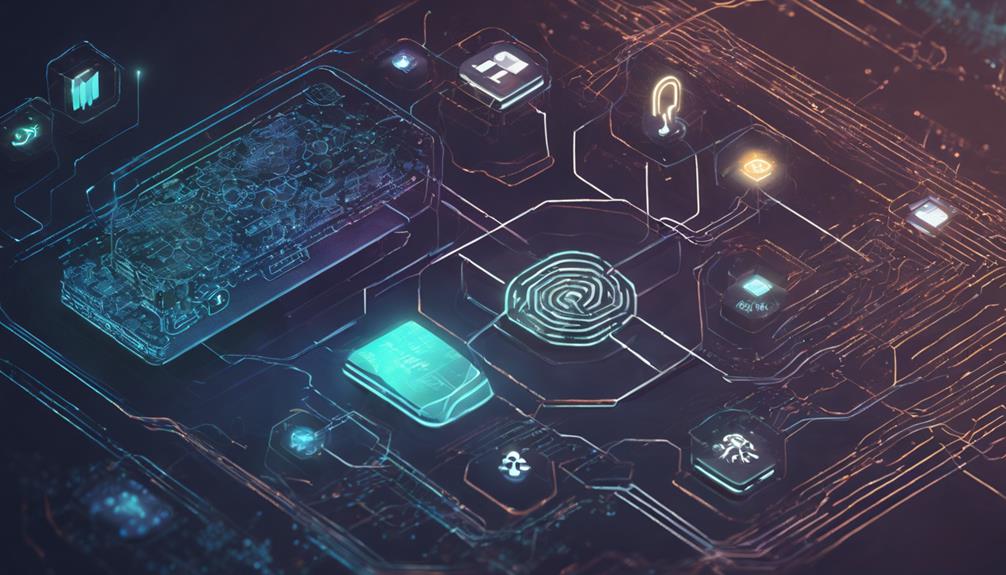Discover high-paying AI cybersecurity roles today. Lucrative positions like Machine Learning Engineer and AI Security Analyst are in demand, offering salaries above $120,000 annually. Enhance threat detection using AI technologies and experience impactful career growth. Roles such as Cybersecurity Architect and Risk Manager provide financial stability while safeguarding digital assets. Leadership opportunities like Chief Information Officer and Director of Information Security shape policies to counter cyber threats effectively. Explore Cloud Consultant and Penetration Tester roles for cutting-edge security practices. These roles offer competitive salaries and room for professional advancement, ensuring a rewarding career in cybersecurity.
Key Takeaways
- Machine Learning Engineer positions in AI cybersecurity offer lucrative salaries above $120,000 annually.
- AI Security Analyst roles in demand for enhancing threat detection and response capabilities.
- Opportunities for impactful career growth and financial stability in AI cybersecurity field.
- Competitive salaries for Penetration Testers, with average national earnings exceeding $119,000 per year.
- Cloud Consultants blend technical skills with strategic thinking to optimize cloud security practices.
Lucrative Opportunities in AI Cybersecurity
The field of AI cybersecurity presents lucrative opportunities for professionals seeking high-paying roles in a rapidly growing industry. Positions such as Machine Learning Engineer and AI Security Analyst require specialized skills in artificial intelligence and cybersecurity, making them high in demand. These roles offer competitive salaries, with some professionals earning over $120,000 annually.
AI cybersecurity professionals are instrumental in enhancing threat detection and response mechanisms through the integration of AI technologies. By developing innovative solutions to combat evolving cyber threats, they pave the way for rewarding career paths within the industry. With the increasing reliance on AI in cybersecurity, professionals in this field have the chance to make a significant impact while enjoying financial stability and career growth.
Pursuing a career in AI cybersecurity not only promises financial rewards but also provides an opportunity to be at the forefront of developing cutting-edge solutions to protect organizations from cyber threats.
Top-Paying Security Engineer Roles

Leading the pack in top-paying security engineer roles is the position of Cybersecurity Architect, commanding high salaries and essential responsibilities in safeguarding digital infrastructure.
Security Engineers in this role are tasked with planning and implementing security measures for computer networks. They play a pivotal role in establishing security standards and testing systems for vulnerabilities that could compromise the integrity of data. Attention to detail is paramount as Security Engineers must identify coding mistakes to guarantee system safety.
With an average national salary of $108,356 per year, these professionals are instrumental in safeguarding systems and data from cyber threats. The demand for skilled Security Engineers continues to grow as organizations prioritize cybersecurity in an increasingly digital landscape.
Pursuing a career in this field offers not only lucrative opportunities but also the chance to make a significant impact in protecting essential information and infrastructure.
Strategic Risk Manager Positions

Strategic Risk Manager positions in AI cybersecurity involve employing advanced risk assessment techniques to evaluate potential vulnerabilities and threats within systems.
These professionals also implement robust compliance monitoring strategies to guarantee adherence to cybersecurity protocols and industry regulations.
Risk Assessment Techniques
Utilizing advanced data analysis techniques, Risk Managers in AI cybersecurity employ innovative strategies to proactively identify and mitigate potential threats.
By analyzing data patterns and trends, Strategic Risk Managers forecast possible risks and develop proactive strategies to counter them effectively.
In the domain of AI cybersecurity, these professionals play an essential role in safeguarding AI systems against evolving cyber threats. Their expertise in risk assessment not only helps in identifying vulnerabilities but also contributes greatly to enhancing the overall cybersecurity posture of organizations relying on AI technologies.
Through the utilization of sophisticated risk assessment methodologies, Strategic Risk Managers enable organizations to stay ahead of cyber adversaries in the dynamic landscape of AI.
Compliance Monitoring Strategies
Effective implementation of compliance monitoring strategies is imperative for Strategic Risk Manager positions in AI cybersecurity jobs. These professionals are tasked with ensuring adherence to industry regulations and standards to mitigate risks effectively.
Here are five key points to take into account when it comes to compliance monitoring strategies in strategic risk manager roles:
- Proactive Solutions: Strategic risk managers must develop proactive solutions to address potential compliance issues promptly.
- Adherence to Regulations: Ensuring that organizations comply with industry regulations and standards is a fundamental aspect of the role.
- Risk Mitigation: Strategic risk managers play a critical role in mitigating risks through effective compliance monitoring frameworks.
- Cybersecurity Protocols: Upholding cybersecurity protocols is a key responsibility for strategic risk managers in AI cybersecurity jobs.
- Secure and Compliant Posture: By overseeing compliance monitoring strategies, strategic risk managers help organizations maintain a secure and compliant cybersecurity posture.
These factors underscore the importance of compliance monitoring in the realm of strategic risk management within the cybersecurity industry.
Leadership as Chief Information Officer

In the domain of AI cybersecurity jobs, the role of Chief Information Officer (CIO) stands out as a pivotal leadership position responsible for overseeing IT and security systems within organizations. CIOs lead the way in managing technology, ensuring software upgrades are implemented efficiently, and teams comply with cybersecurity best practices. They are instrumental in setting security policies, managing cybersecurity aspects, and safeguarding company information against cyber threats. Here is a breakdown of the key responsibilities of a Chief Information Officer in the cybersecurity field:
| Responsibilities | Description |
|---|---|
| Overseeing IT Systems | Managing technology and software upgrades |
| Team Compliance | Ensuring teams comply with cybersecurity practices |
| Security Policies | Setting and implementing security policies |
Chief Information Officers are crucial in driving the protection of valuable company data and systems, making their role indispensable in the cybersecurity landscape.
Cutting-Edge Cloud Consultant Jobs

Cutting-edge cloud consultant jobs are at the forefront of cybersecurity trends, requiring a blend of technical skills and strategic thinking.
These professionals must stay updated on the latest cloud security practices to protect sensitive data effectively.
With expertise in customizing cloud systems and optimizing platforms, cloud consultants play a crucial role in ensuring robust network security against cyber threats.
Cloud Security Trends
Cloud security trends in the domain of cutting-edge cloud consultant jobs are evolving rapidly to meet the escalating demands for data protection and system integrity in the digital landscape.
- Cloud consultants are focused on securing cloud solutions to safeguard clients' data effectively.
- They customize cloud platforms to guarantee data protection meets specific security needs.
- These professionals play an essential role in maintaining and securing cloud systems against cyber threats.
- System maintenance is a key task for cloud consultants, as they continuously optimize cloud security measures.
- Ensuring compliance with strict security guidelines is a top priority for cloud consultants to mitigate risks effectively.
As the digital world advances, the role of cloud consultants in enhancing data security becomes increasingly important. With their expertise in securing cloud solutions, these professionals are at the forefront of defending against cyber threats and maintaining the integrity of cloud platforms.
Skills for Consultants
With the rapid evolution of cloud security trends, professionals in cutting-edge cloud consultant jobs must possess a diverse set of skills to effectively secure cloud solutions and protect data integrity.
Cloud consultants play a critical role in determining and implementing secure cloud solutions tailored to meet clients' specific security needs. They are responsible for maintaining and safeguarding cloud-based data, ensuring system security compliance, and designing and auditing network safety measures to detect and eliminate threats efficiently.
These consultants are instrumental in ensuring network sustainability and resilience against cyberattacks, emphasizing the importance of data protection in today's digital landscape.
Data Safeguarding as Director of Information Security

In the position of Director of Information Security, ensuring data safeguarding is vital to the overall success of cybersecurity measures within an organization.
- Establishing robust security policies is essential to mitigate risks effectively.
- Leading a team of security analysts to monitor and respond to potential data breaches promptly.
- Implementing security protocols to safeguard sensitive information and prevent unauthorized access.
- Collaborating with the Chief Information Security Officer to align strategies with overall business goals.
- Utilizing programming languages to develop tools for vulnerability discovery and data security enhancement.
As a Director of Information Security, you will play a pivotal role in fortifying the organization's information technology infrastructure against cyber threats. Your responsibilities include overseeing security measures, training employees, and designing effective security systems. With an average national salary of $152,706 per year, this role offers a rewarding career path for those skilled in data protection and cybersecurity strategies.
High-Demand Penetration Tester Roles

As the demand for cybersecurity professionals continues to grow, the role of penetration testers is increasingly important in identifying vulnerabilities and enhancing security measures within organizations. Penetration testers play a critical role in simulating breaches to uncover weaknesses that malicious actors could exploit, thereby preventing potential cyberattacks.
Their responsibility lies in testing and fortifying security protocols to safeguard sensitive data and guarantee the integrity of system security. With an average national salary of $119,538 per year, penetration testers are highly sought after in the cybersecurity field. They have the option to offer freelance consultancy services or work in-house to bolster cybersecurity defenses.
Frequently Asked Questions
What Is the Highest Paying Role in Cyber Security?
The highest paying role in cybersecurity is the Chief Information Security Officer (CISO), commanding an average salary of $242,481. CISOs require a blend of technical expertise, strategic vision, leadership skills, and a CISSP credential.
Can I Make 200K a Year in Cyber Security?
Yes, achieving a $200,000 annual salary in cybersecurity is feasible for seasoned professionals with the right skill set, certifications, and experience. Roles like Director of Information Security, Security Architect, and Chief Information Security Officer often offer salaries surpassing this mark.
How Much Do You Make in AI Cyber Security?
Professionals in AI cybersecurity can earn between $100,000 to $200,000 annually, with top specialists exceeding $200,000. Salaries are influenced by factors like location, industry, and expertise in areas such as machine learning and data analytics.
Is AI and Cyber Security a Good Career?
Combining AI and cybersecurity offers a promising career path. The evolving landscape of cyber threats necessitates skilled professionals adept at leveraging AI technologies for robust defense mechanisms. Pursuing this field can lead to fulfilling roles safeguarding critical data.
Conclusion
In the domain of AI cybersecurity jobs, the opportunities are as plentiful as stars in the night sky, each one holding the promise of a lucrative and fulfilling career.
With roles ranging from security engineers to penetration testers, there is a path for every individual seeking to protect and defend against digital threats.
Embrace the challenge, hone your skills, and step into the world of cybersecurity where your expertise will shine brightly in the ever-evolving landscape of technology.









